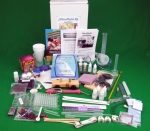Chemistry lab work can be scary if you don't know what you're doing. Danger coupled with the high cost for lab equipment and chemicals has been enough to deter many homeschooling parents from even attempting to cover chemistry at home.
MicroChem Kit is a chemistry lab kit that eliminates much of the danger while keeping the price very affordable. It accomplishes this by scaling back the amount of each chemical used in the experiments (they say about 1/100th the amount typically used!), using appropriately scaled-down equipment and plastic wherever practical, and using dilute rather than concentrated chemicals for safety. Chemical reagents are in small "dropping" bottles that function sort of like eye droppers, but a bit more sophisticated and controlled than that. (Students should practice with the distilled water bottle before the chemical bottles to get the feel for how they work.) There's less mixing, spilling, and clean-up but the difficulty is in carefully counting the drops and in holding the bottle at a proper angle so that you get consistent size in the drops. When working on such a small scale, a single drop can make a huge difference in results.
A kit contains "sufficient materials to perform every experiment five times" according to their literature. I expect that some experiments will need repetition because the small amounts of chemicals used might make results more difficult to pinpoint without more than one trial. You will need to gather some household items such as distilled water, food coloring, graph paper, and narrow-nose pliers.
MicroChem Kits has also created charts showing which of their experiments correlate with which lessons in chemistry courses from Apologia, BJU Press, School of Tomorrow, Alpha Omega, and A Beka Chemistry as well as Glencoe Science, Chemistry: Matter and Change. You can easily correlate the experiments with any other basic chemistry text.
The kit comes with a 200-page instruction manual for 31 experiments. For each experiment, the manual explains the goals, materials/equipment needed, background information, and step-by-step procedure. Then it includes charts and questions for recording and analyzing results. The student should be drawing primary instruction from a basic text rather than from the lab manual, so explanations are not lengthy. Experiments also assume the student's knowledge of algebra which is required for equations and graphing. Correct results and answers to questions are provided at the back of the book; these pages can easily be removed by the teacher.
The author has given permission to photocopy the student "result" pages from the manual so that a teacher/parent might work with more than one student at a time. Each student should really have his or her own kit to perform experiments independently, although two students working closely together might share a kit. If you should need an extra lab manual, the cost is $24.95.









